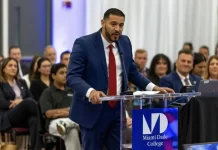|
Getting your Trinity Audio player ready...
|
To begin with, I must make it very clear that the opinions and comments being expressed here are as a private citizen and do not necessarily represent those of Zoo Miami, or any Miami-Dade County government entity.
On September 6, the Miami-Dade County Board of County Commissioners (MDC BCC) will be voting on whether to extend the lease agreement for a theme park called, “Miami Wilds,” on Zoo Miami property. With all the information and data that has become available over the last several years, and for the sake of some of Florida’s priceless natural treasures, this extension should be denied.
When I began my career over 43 years ago, I did not come to work at the zoo simply to work for an attraction. My goal then and now has always been to work for a conservation organization that would be committed to protecting wildlife in the wild where it belongs. I would never support taking an animal out of the wild to be put in captivity unless it was a desperate effort to save that individual animal’s life or the species it represents and certainly would not support eliminating endangered habitat needed for that species to survive.
The greatest overall threat to wildlife today is habitat loss. Zoos must make every effort to protect not only wild animals, but more importantly, the wild environments in which they live. That is a massive challenge as the human population continues to grow and development continues to encroach into wild habitats.
Zoo Miami sits on a 740-acre parcel of land that contains the largest fragment of pine rockland habitat outside of Everglades National Park. This fragment is the most biodiverse habitat in South Florida and pine rockland is a globally critically endangered ecosystem. Within this parcel of land lives a variety of endangered and federally protected species including the Florida bonneted bat, Bartram’s scrub hairstreak butterfly, rim rock crowned snake, Miami tiger beetle, and the gopher tortoise. In addition, there are many known imperiled species that have not yet been officially classified due to data deficiency, but initial indications are that they would certainly warrant protection once enough data is collected. In total, there are 110 imperiled species known to exist around the zoo. Many of these species are found nowhere else on earth and new species are being discovered almost every year!
Over the past few years, we have seen more of the highly endangered pine rockland and adjoining habitat surrounding the zoo plowed over to make room for retail stores, restaurants, a Wal Mart, an L.A. Fitness, and hundreds of apartments. Not only have these projects eliminated vital habitat for wildlife, they have also contributed exponentially to overwhelming traffic on Coral Reef Drive that can often make a drive of less than a mile seem to last forever. As a zoo employee, I was told that I was forbidden from commenting on that development though it went against everything I (and supposedly the zoo!) stand for. I am profoundly regretful and ashamed for listening to those directives and not speaking up when I should have. Ironically, that project, known as “Coral Reef Commons,” now serves as an example of environmental degradation, along with broken promises and lack of compliance.
The public was assured that the Habitat Conservation Plan (HCP) put forth by Coral Reef Commons and accepted by the United States Fish and Wildlife Service (USFWS), would mitigate any significant detrimental effects of the surrounding habitats past what they already authorized through the endangered species take, often referred to as kill permits. However, the execution of this HCP has already been showing non-compliance by the developers and the effects on the surrounding habitats have already been seen.
There are lighting requirements, although minimal, in the HCP to prevent the detrimental effects of light pollution to the flora and fauna in the surrounding preserves, both public and private. Lighting is supposed to be shielded from directly entering the pine rocklands and is not to be pointed upwards to minimize sky glow and interfere with Florida bonneted bats. The lighting around the Wal Mart has no shielding except for a select few with partial shielding directly in the edge of the preserves. The rest of the lighting is on tall poles that give light pollution into the sensitive areas. No regulation or alteration of signage or in store lighting has occurred. The new El Car Wash and LA Fitness facilities are totally in non-compliance with the HCP. USFWS failed to include in the HCP any regulations to do with the spectrum of the lighting. This is a key aspect of light pollution mitigation. Simply installing lights with long wavelength spectrums into the amber and reds will satisfy the county’s candlefoot requirements without being perceived by most wildlife. This shows how HCPs are often ineffective in protecting against detrimental harm to adjacent habitats and once agreed upon, leave little obligation for corrections.
Even the climate has changed in the adjacent properties due to the development of Coral Reef Commons. Coming into the zoo in early mornings there used to be a fog along the main entrance drive that bathed the surrounding forest in critical moisture at the beginning of the day. Now that moisture and fog are no longer present. This puts the forest in a more dry and vulnerable state at greater risk of wildfire and stress to the species that depend on it. The condensation from this morning fog is likely critical to many of the imperiled species that reside in the pine rocklands.
The promises by the developers of traffic mitigation have yet to be realized. The increase in traffic, the blocking of intersections, the backup of traffic going to the Turnpike have gotten exponentially worse since construction began at Coral Reef Commons. The addition of two dedicated turn lanes, one to the zoo and one to the Starbucks have done little to mitigate the now increased burdens put on the public roadways. I had repeatedly asked for traffic studies to justify this project and though was assured I would receive them, never did. With additional housing development at Coral Reef Commons in the plans, there seems to be no path forward except for this to get worse. Sadly, the solution that was proposed to help alleviate the traffic congestion and provide zoo employees with access to the zoo for work is to build additional roads over more critical habitat within the zoo property, further endangering several of the protected species.
The disturbances caused by the construction of Coral Reef Commons set into motion an unforeseen cascade of events that led to a public health emergency across Miami-Dade County and cost Miami-Dade County residents millions of dollars. According to USDA biologists at the National Rabies Management Program, they have seen similar events occur. When development disturbs natural areas, rabies vector species such as racoons and foxes get displaced from their established home ranges. These highly territorial animals must then try to establish a new home range in already saturated populations in adjacent areas. This leads to stress and conflict which increases the chance of rabies transfer. A racoon with rabies can become disorientated and travel several kilometers in a single day. This can lead to rabid animals then radiating out from the site of disturbance and into the community. This seems to be exactly what occurred after the onset of construction at Coral Reef Commons. Neurologic raccoons began to appear on zoo property and came back from the state labs as being positive for rabies. This led to a public health emergency declaration and posed significant risk to the people of Miami-Dade County, visitors to Zoo Miami, and the animals that reside there. The subsequent oral rabies vaccination program cost millions of dollars in rabies bait distribution and advertising across Miami-Dade County over a three-year period. Zoo Miami Veterinarians had to spend a tremendous amount of time and expense protecting the resident animals, responding to abnormal wildlife sightings, and putting themselves at risk to help control and monitor the outbreak. The known outbreak extended east to the area around the Deering Estate and north to domestic cats in the northern areas of the county.
Now, Miami Dade County is working with a developer, Miami Wilds, to add a water park to the zoo’s property located in the west parking lot. This project has gone through several transformations since it was first voted on in November of 2006. The County signed a lease with the developer in June of 2022. It now is in litigation as conservation organizations have filed suit against the County alleging that they were not in compliance with the original referendum that allowed for the development and operation of commercial uses “on Metrozoo property that is not environmentally sensitive and is outside of the animal attractions.” The fact is that it should be obvious that this land is environmentally sensitive as it is utilized by protected species. This was further confirmed when the U.S. Fish and Wildlife Service proposed that this property be officially designated as “critical habitat.”
The Florida bonneted bat, the most critically endangered bat in the country, forages in large, dark, unobstructed, open spaces with natural or semi-natural flora immediately adjacent to it. It is these landscape characteristics that are critical in its ability to forage and find food. What used to be prairies and grassy wetlands adjacent to pine rocklands and hardwood hammocks in Miami-Dade County are all but gone from the bats’ natural conditions in which to find food. Replacing these areas, but still providing the same landscape characteristics are golf courses, large artificial lakes, open green spaces in parks, and large unlit parking lots. These are mimics of the former natural habitat that was once available, and all are becoming increasingly rare in Miami-Dade County due to uncontrolled development.
For the proposed Miami Wilds development, it is often stated, “It is just a parking lot.” It is currently mostly a parking lot, but as previously stated the landscape characteristics are important for the federally endangered Florida bonneted bat. No one is saying that the bats are crawling around on the pavement at night. It is the large, dark, unobstructed, open spaces with the incredibly diverse pine rockland immediately adjacent to it that creates the airspace above the project area that satisfies the needed habitat replacement for the bat. To put it into perspective, when a portion of the ocean is protected, is it just the ocean floor or is it the entire column of water moving upward that is utilized by species that never touch the ocean bottom? One must understand the bat’s ecology to understand how what you see during the day as “just a parking lot” is transformed at night to a critical, and increasingly rare, foraging area.
The vote that occurred with the Miami-Dade County Board of County Commissioners that authorized the project to move forward was done under misleading and false pretenses given to the commissioners and left many on the board who asked about the environmental concerns with no one qualified or willing to speak at the meeting to answer them. Only a portion of the site is actually paved. There are many tree islands between the parking lanes in the southern part of the proposed site. The northeastern portion is dominated by grasses and plants that have consumed most of the area of the landing pad and runway of the former military base on the site. In addition, then Commissioner Cava, asked about the claim that the parking area is already fully lit. The answer she received was misleading and inaccurate. You can visit any evening at the zoo and see the actual state of the parking lot is completely dark and even when temporary event lighting is brought in, it only operates until the end of the night event.
Over the last decade, research has shown that the parking area is a crucial foraging area and alterations to it by placing obstructions (buildings, slides, and light poles) and placing lighting will make that location no longer suitable for the bat to utilize and create a critical food shortage in the area that now supports the largest known population left of and a genetically distinct population of the species. One only needs to look next door to Coral Reef Commons at how a former foraging area for the species is now not supporting foraging or roosting of the Florida bonneted bat any longer.
I am not an attorney and have no intention to argue the legal merits of this case. For the record, I, and my co-workers, have been explicitly told by senior management in the County that we are forbidden from publicly commenting on this issue and that all inquiries must be referred to the Mayor’s office. I understand that by commenting as a zoo employee, it would subject me to charges of insubordination so, I want to again make it clear that my comments here are not as a zoo employee but rather as a deeply concerned citizen who has watched unbridled development slowly erode away the priceless natural treasures that make Florida one of the most beautiful and biologically diverse states in the country. I can no longer just sit back and watch developer dollars dictate the future of Miami-Dade County, especially in my own backyard. I must ask, how can the zoo profess to have conservation as a main pillar, yet allow for this project to continue on its own property? It is the definition of hypocrisy! The bottom line is that if in captivity in a zoo is the last place where certain animals can live, then zoos as institutions have failed in what should be their number one priority – to ensure that the species of animals they choose to exhibit can live in the wild where they truly belong.
Some may ask, “What is so important about protecting a bat, a tortoise, some bugs and plants?” The fact is that we are all connected. Whether it is the bats that feed on the insects that can spread disease and cost millions in agricultural damage, or the bugs that help pollinate the plants that help feed us and the animals that are critical to the health of the environment we live in, or the tortoises that spread the seeds that help maintain critical diversity while providing homes for many other species, by protecting these species, we are protecting ourselves. Zoo Miami uses as its brand mantra, “Connecting, Caring, Conserving.” It is time to truly demonstrate that.
I understand the desire and economic benefits of having a water park in South Florida and would fully support it in the proper location. What we now know makes it abundantly clear that Zoo Miami is not the proper location. We are constantly hearing from our leaders that we should “act locally and think globally” when it comes to conservation. It doesn’t get any more local than this. It is time to act now and deny the lease extension of Miami Wilds at Zoo Miami and look for a more suitable location.
Respectfully,
Ron Magill
Private Citizen






